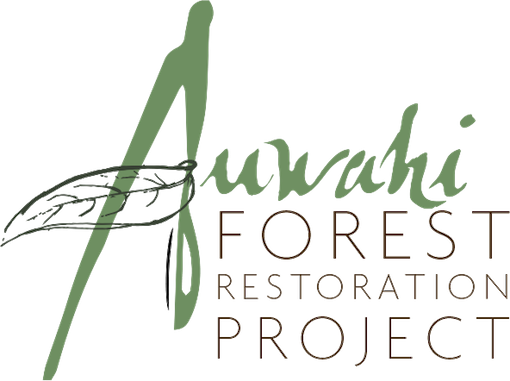'Hawai'i's tragic dismemberment'
W.C. Gagne
Since days of old, however, Auwahi has been greatly transformed by burning, grazing, and the invasion by non-native plant species. As a result, much of the original native understory at Auwahi has been replaced by a thick, smothering green mat of aggressive African Kikuyu grass, introduced as cattle forage.
To many, Auwahi is known as a “museum forest”. Through ancient, majestic trees of nearly every Hawaiian dryland species can be found there, most species have no seedlings and have had none for the past 50 to 100 years. Just like a museum filled with artifacts, these forests, in one sense, are no longer living, but just persisting in a type of shadow state, one windstorm away from becoming a pasture. By examining sub-fossil bones, we now know that these dryland forests at one time supported a tremendously diverse community of Hawaiian birds, from giant flightless geese (moa nalo) to the loud, sweet-singing, yellow and black honeyeaters. Now, except for the light twittering of white-eyes and occasional mynah squawk, the forests are quiet as a museum…
Aerial photograph of Auwahi forest, 1950s.
Aerial photograph of Auwahi forest with forest exclosures. Note continued loss of native forest trees in the past decades.
Today, Auwahi forest probably bears little similarity to that prior to human contact. Currently, in central Auwahi, vegetation consists largely of scattered individuals and small groups of native trees scattered within a pasture like understory of a thick mat of kikuyu grass. The terrain is sloping from approximately 20-30 degrees, comprised predominantly of thin rocky ridges and interconnecting gullies and slopes. Throughout, the substrate is extremely rocky with sparse soil accumulations.
The catastrophic changes that have taken place in the native vegetation of leeward forests have been accompanied by the near wholesale loss of native birds and invertebrates. Only four native bird species occur at the site: the `apapane (Himatione sanguinea), amakihi (Hemignathus virens), pueo (Asio flammeus), and rarely the `i`iwi (Vestiaria coccinea). Of these, probably only the pueo is a resident species that nests in the area. The other three are nectar-feeding honeycreepers that come makai (seaward) into upper Auwahi only when the mamane and `ohi`a are flowering.
The transition from this intact forest to the current degraded condition of mostly isolated trees or small stands of trees scattered in a pasture-like setting began apparently in the late 18th century. During this period, Rose Ranch (currently `Ulupalakua Ranch) was cleared with fire of shrubby vegetation to enhance its value as pasture (Lennox 1967). The area was used for grazing cattle but also became progressively invaded by a weedy Mexican shrub (Ageratina adenophora). For 30 years (1915-1945), Auwahi had "a nearly solid understory" of the invasive plant. In 1945, a tephritid fly (Procecidochares ultilis) from Mexico was introduced as a biological control agent in efforts to combat the Ageratina weed. In conjunction with a drought, Ageratina populations became drastically reduced.
After the Ageratina decline, kikuyu grass (Pennisetum clandestinum), native to Africa, was planted along the roads in the late 1940s to enhance cattle pasturage. This mat-forming grass does not produce seeds in Hawai`i but instead reproduces asexually with vigorous rhizome and stolon production. Quickly, kikuyu grass spread and began to dominate the understory at Auwahi, by 1967, reaching a virtual monoculture (Lennox 1967). At Auwahi, kikuyu grass repeatedly overtops itself, in places producing more than three feet (1 meter) of thickly matted stems and leaves over blocky `` lava substrates.
The tree density and diversity is greatest in western Auwahi, drops off dramatically in eastern Auwahi, and becomes practically pasture with scattered Nestegis trees by the boundary of the Auwahi-Luala`ilua districts. Presumably, the younger, less eroded, rockier substrates of western Auwahi have afforded greater protection from fire, ungulates, and some weeds.
References:
Lennox, C. 1967. Auwahi Forest Report; Appendix 6. Unpublished report, 3pp.
Chronology of Auwahi district
late 1800s
Lennox (1967) wrote, "In the last half of the century cattle raising as a ranching enterprise gained headway and undergrowth, particularly pukeawe and `a`ali`i, was destroyed by fire to make way for imported forage grasses. Natural reproduction came to an end for many species."
1887-1912
Hosmer (1912) writes of vegetation in adjacent Kula districts, "belt of heavy forest with dense undergrowth in the Kula districts between the elevations of 3500 and 5000 feet...Gradually opened up by grazing until now it has practically disappeared save as its former extents can still be traced by dead stubs..."
1910
Joseph Rock first visits Auwahi, makes extensive collections, and remarks about its botanical value in his 1919 book, Indigenous Trees of the Hawaiian Islands.
1920-1921
Charles N. Forbes explores Auwahi, makes extensive collections, and provides some of the best early documentation of the area in his unpublished field notes.
1915-1945
The western portion of Auwahi is protected from cattle grazing by "nearly solid understory" of the weedy Mexican subshrub, Ageratina adenophora.
1939
After nearly 20 years absence, Joseph Rock returns to Auwahi and is reported to have wept at the deterioration of the Auwahi forest.
mid- to late 1940s
A biological control agent insect is introduced to control Ageratina. The program is successful and in conjunction with a drought, the weed is virtually eliminated.
late 1940s
kikuyu grass is introduced into the former Auwahi forest to enhance its use as pasture
1967
Colin Lennox and The Nature Conservancy make the first attempt at conservation of Auwahi forests by constructing an exclosure. Due to lack of successful kikuyu grass control, the project is generally perceived as a failure, and the cattle are released back into the exclosure.
early 1980-present
The Native Hawaiian Plant Society (NHPS) builds eleven small exclosures to protect patches of native dryland trees at Auwahi.
1997-present
A multi-agency cooperative effort is made at an experimental dryland forest restoration project at a 10 acre exclosure in western Auwahi. Partners include ‘Ulupalakua Ranch, Biological Resources Division, U.S. Geological Survey (BRD-USGS), U.S. Fish and Wildlife Service (USFWS), Native Hawaiian Plant Society (NHPS), and Living Indigenous Forest Ecosystems (LIFE).



